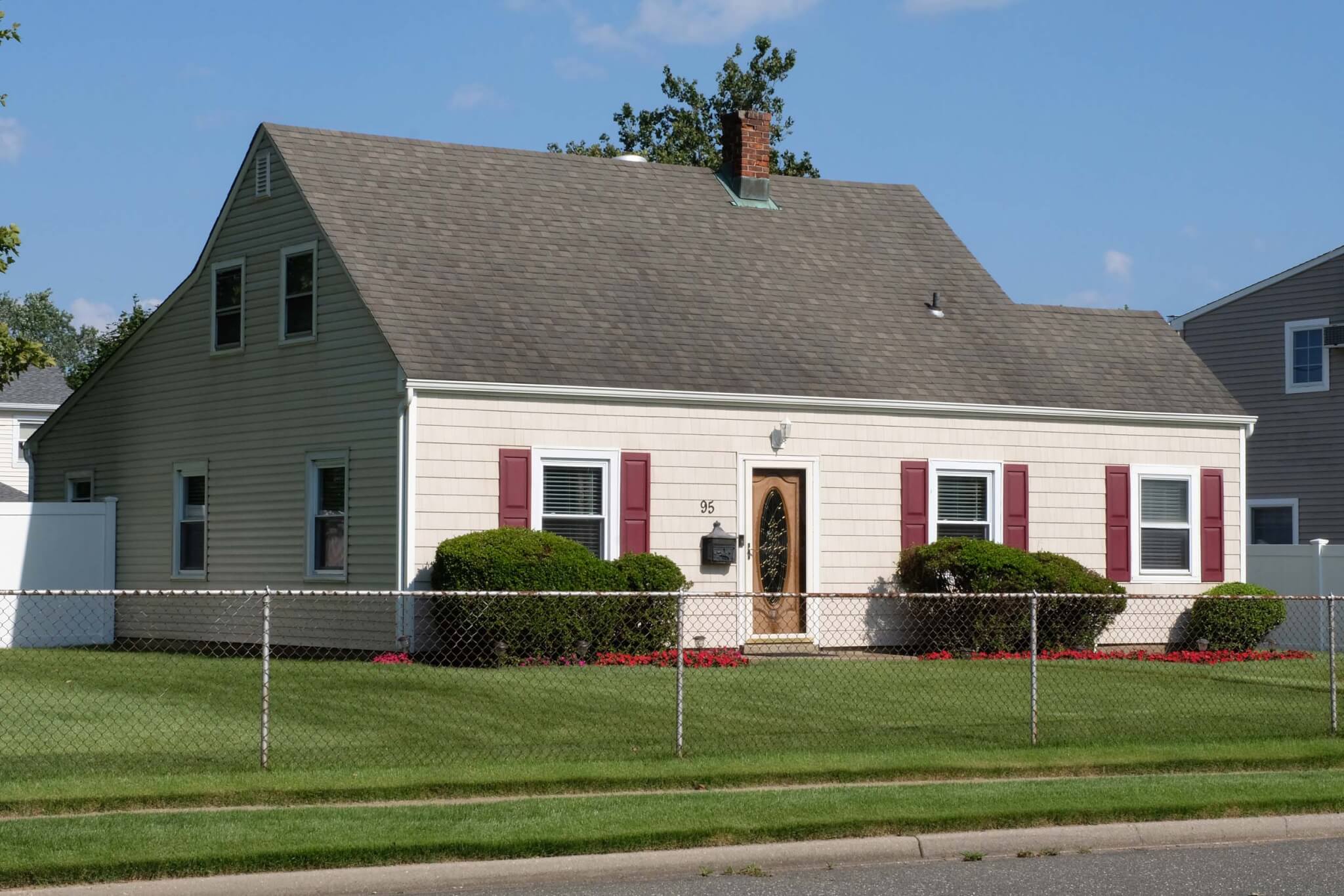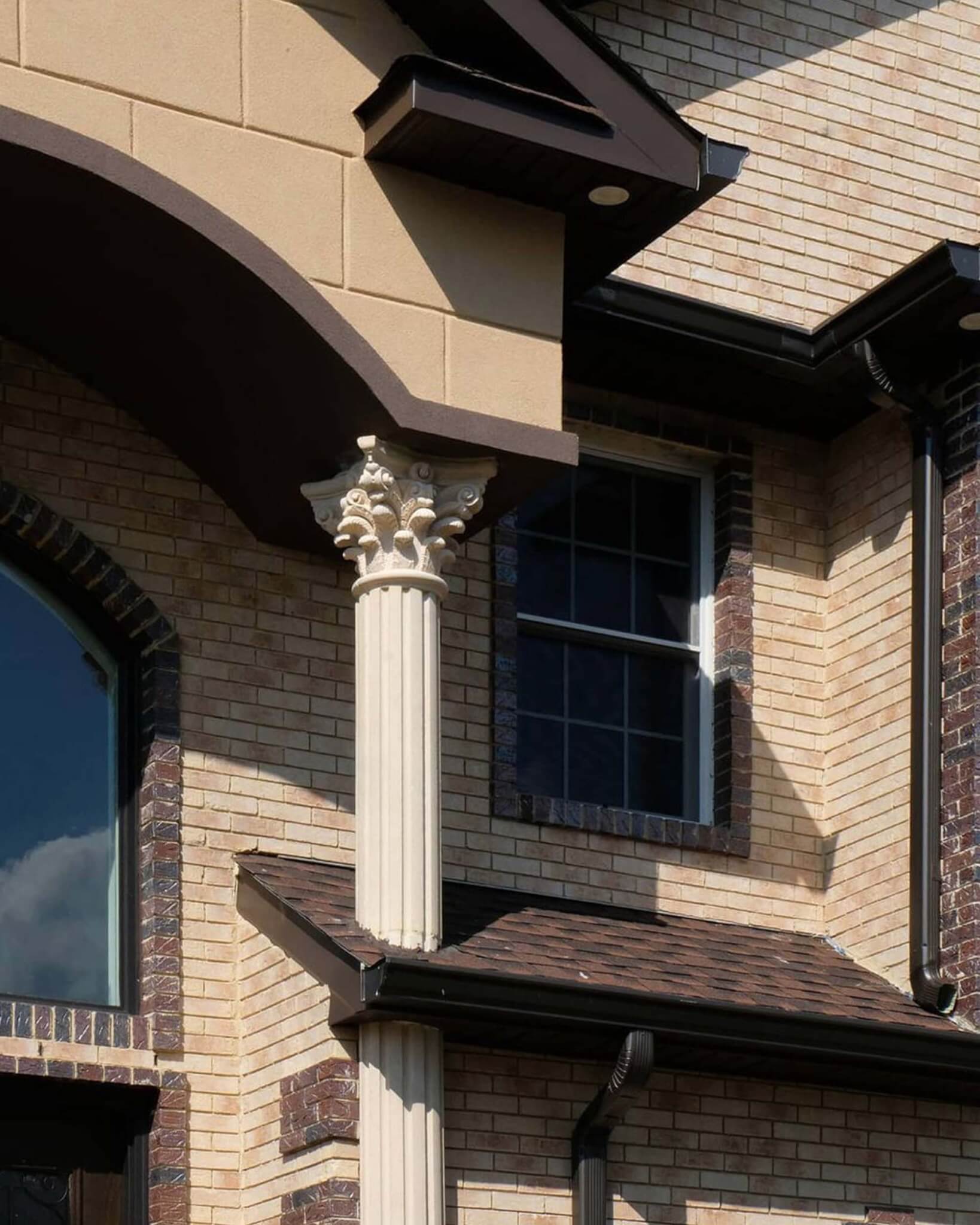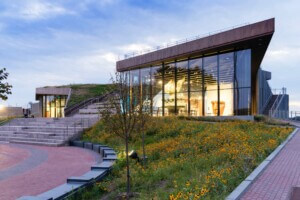Facades, cluttered. Materials, uncomplimentary. Bathroom tiles glisten at the base of a facade, and glass railings on Juliet balconies cast distorted reflections of plastic triangular profiles. In Levittown, New York, the desire for symmetry is often present but rarely achieved. Here, the iconic image of the American dream house is simultaneously broken and multiplied, and now it’s selling for over a million bucks.
The infamous postwar suburb that standardized midcentury ills like sprawl, white flight, and exclusionary zoning broke ground in 1947 and initially catered to middle-class families looking for a fresh start. A starter home—mass-produced, balloon-frame, and endlessly replicated—originally sold for around $8,000 (about $110,500 today). But the new million-dollar renovations of those original houses are fully loaded and ready to compete with their far younger (and bigger) imitators. While clearly trying to match the character that surrounds them, their scrambled compositions and exaggerated qualities—brightened, weightless—appear to belong more to the ephemerality of social media feeds than the durability of buildings that might last for generations.
Many likely anticipated this kind of development in 21st-century Levittown and countless neighborhoods like it. In the 1950s, aesthetics were controlled here by the community’s self-imposed social codes. Yet with today’s ubiquitous digital content aggregation, the once-cohesive Americana setting now yields to a new totality: an algorithmically driven cycle of production that’s spawning a new domestic reality, all with just a few taps.

A Broken Picture
Announcing “the end of the world” in 2013, Timothy Morton argued that “hyperobjects,” like the internet and climate change, have broken our picture of a stable reality that’s determined by us. As explained in Hyperobjects: Philosophy and Ecology After the End of the World, these complex objects are pervasive, operate at scales and frequencies beyond our total comprehension, and don’t allow us to resolve them within our existing frameworks. In this context, one’s reality, or “world picture,” is seen as shaped by aesthetics. When elements from outside the frame enter the scene, the nature of reality, subject to the influence of its parts, comes into question. As familiar elements are replaced or reoriented, boundaries and meanings become altered or subverted, even subtly, as if an old phrase were now spoken with a different intonation.
The world of Levittown began as an actual picture: a watercolor sketch of a modest house enclosed within a clearly defined frame. Lush foliage surrounding a perfect lawn under a clear spring sky caressed each and every residential miniature. This world picture offered an ideal blend of traditional values and modern convenience, and as a bare-bones model, it contained immense DIY potential, representing for residents the epitome of American individualism.
In a cycle of symbolic exchange, the act of remodeling the home would improve one’s individual condition while also contributing to the larger picture of the community and, by extension, the nation. The Levittown American’s quest for independence and freedom, like that of the early settlers, meant that the house was the stage upon which one’s allegiance to the nation was performed. Capturing this belief, the protagonist in W. D. Wetherell’s fictional story The Man Who Loved Levittown passionately recalls: “I’ll never forget those years. The fifties. The early sixties. We were all going the same direction…. Thanks to Big Bill Levitt we all had a chance. You talk about dreams. Hell, we had ours…. We were the pioneers.”
Prior to widespread internet use, Levittown maintained a largely coherent architectural identity despite ongoing renovations throughout its 70-year history. Early on, homeowners began experimenting with dormers, bay windows, vinyl siding of various colors, brick and stone elements, fencing, and backyard swimming pools. It wasn’t long before a substantial proportion of the original 17,447 freestanding houses—all initially featuring plain asbestos facades and unfinished attics—had been modified to resemble unique homes. From the perspective of residents, it must have seemed that each of their architectural creations distinctly reflected its owner’s very own values and aspirations, but the community’s social codes were a dominant force. As documented in Barbara Kelly’s Expanding the American Dream: Building and Rebuilding Levittown, residents sought mutual acceptance by undertaking renovations within the realm of what was readily observable, deemed appropriate, or considered successful.

Levittown’s 20th-century coherence was a predictable outcome of its mass production, combined with the well-known exclusionary practices of its real estate developer, Levitt and Sons. In the 21st century, with the internet’s instantaneity at our fingertips, Levittown has evolved at odds with its former insularity. As materialized objects of digital content populate the scene, suburbia is spilling beyond the world-protecting confines of lawns, foliage, and sky.
Levittown Now
The visual remnants of Levittown’s former social regime now give way to newer, slicker elements that appear stunted by an inability to communicate. Despite social media’s goal of streamlining communication, one result of this convenience is an alien language of architectural products-as-symbols devoid of a previous generation’s grand narratives. The new Levittown home is flattened with white paint, black window frames, and minimally geometric fencing, porches, and doorframes. It’s unable to offer any idea other than that of a desirable ROI when the asset has been exhausted. The newly renovated houses still resemble variations on their original model only now, they sit on maxed-out footprints like voiceless inflatable monsters, trapped within invisible cages of zoning jurisdiction.
The Levittown of today espouses a dark optimism. No longer is the community centered by misguided nationalism. The threat of the Cold War is gone, replaced by other existential anxieties that call for stronger lifestyle remedies. Yet a neat package of luxury seems wholly unattainable in this mass-produced context, where elements are not only of an unconvincing quality but also assembled without intent. No particular composition suggests a level of certainty or stability. Looking from the street, the new doors, windows, and roof profiles form surprising misalignments on facades that resemble generated versions of McMansions from real estate TikTok.
Who’s Driving?
Today’s consumer-as-architect plays an increasingly regimented role in the design process: interacting with the social media interface, inputting basic information, activating desired imagery with a split-second pause. Architecturally speaking, the result is without resolution at the scale of the whole. Proportions are odd, both outside and inside, where even more amenitization takes place. Floorplans are either complicated or entirely open, signaling that clarity is less obtainable than the devices and perks that populate a home’s much-scrolled listing on Zillow.

In the 1948 comedic film Mr. Blandings Builds His Dream House, a young couple relocates from their small apartment in Manhattan to the Connecticut countryside. While planning their new home, Mr. and Mrs. Blandings push their architect to the side and scribble all over his well-thought-out plan: “A built-in bar here and a walk-in closet there,” they command. “How about a bathroom for every bedroom—all five, yes. Now add a sewing room, a playroom in the basement, and a terrace just outside the study with a little awning.” To the audience of 1948, the result is a monster. The couple can’t see the whole picture, but the architect, presumably, can.
In the age of the algorithmic image, aesthetics in Levittown are no longer driven by any community of individuals—as limited and segregated as they were—partaking in mutual dialogue. Instead, algorithms rapidly feed new imagery into the builder’s working palette. This totality operates through pure economics. It caters perfectly to its market, unbothered by factors of human comprehension with which to discriminate. Mr. and Mrs. Blandings’ condition—an inability to conceptualize a coherent whole—has become universal.
Steven Sculco is a designer based in New York.











